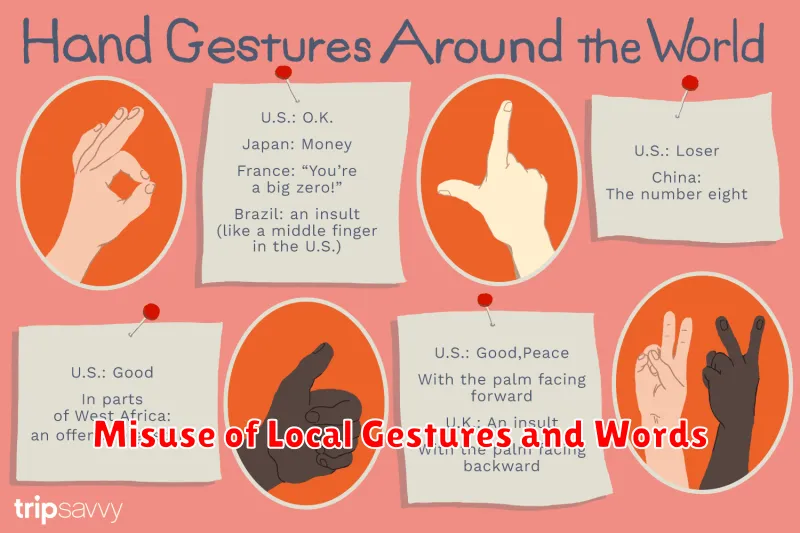Traveling to new and exciting destinations is a wonderful experience, but it’s essential to be mindful of cultural etiquette. Cultural etiquette mistakes can inadvertently cause offense and create uncomfortable situations. This article will explore some of the most common cultural faux pas committed by tourists, offering valuable insights to help you navigate different cultures with sensitivity and respect. From greetings and dining customs to gestures and dress codes, understanding cultural norms is key to a positive and enriching travel experience. Avoid common tourist blunders and foster meaningful connections with locals by learning about cultural etiquette beforehand.
Many travelers are unaware of the cultural differences that exist around the world. What may be perfectly acceptable in one country can be considered rude or disrespectful in another. This article will serve as a guide to avoiding common cultural etiquette mistakes. We’ll delve into specific examples of cultural missteps and provide practical advice for navigating cultural sensitivities. Whether you’re planning a trip abroad or simply want to expand your cultural awareness, this guide will equip you with the knowledge you need to show respect and appreciation for the cultures you encounter. By being mindful of cultural etiquette, you can ensure a smoother, more enjoyable and respectful journey.
Why Etiquette Varies Around the World
Etiquette, the customary code of polite behavior in society or among members of a particular profession or group, is not universally standardized. It varies significantly across cultures, influenced by a complex interplay of historical, religious, social, and environmental factors.
History plays a crucial role. Centuries of tradition, unique customs passed down through generations, shape how individuals interact. For example, bowing is a deeply ingrained sign of respect in many Asian cultures, stemming from historical hierarchies and social structures.
Religion also heavily influences etiquette. Religious beliefs often dictate acceptable behavior, impacting everything from greetings and dining practices to clothing choices. In some cultures, modesty is paramount due to religious tenets.
Social norms, the unwritten rules that govern social interactions, contribute to the diversity of etiquette. Concepts of personal space, directness of communication, and even acceptable levels of eye contact differ widely across cultures.
Finally, environmental factors can also subtly shape etiquette. Resource scarcity, climate, and population density may influence social customs and behaviors.
Unintentional Offenses in Common Destinations
Traveling to new places exposes us to different cultures and customs. Often, what is considered polite in one country can be highly offensive in another. Tourists, through no fault of their own, can unintentionally commit cultural faux pas that may cause offense to locals.
In some East Asian countries, for example, sticking chopsticks upright in a bowl of rice is reminiscent of funeral rituals and is considered extremely disrespectful. Similarly, in many Middle Eastern and some Asian countries, the left hand is considered unclean, and it is rude to offer or receive items with that hand.
Public displays of affection, while commonplace in some cultures, can be frowned upon or even illegal in others. Certain gestures, like the “thumbs-up” sign, can be offensive in parts of the Middle East and West Africa. Speaking loudly in public places is also seen as disrespectful in many cultures where a quieter demeanor is valued.
Misuse of Local Gestures and Words

One common oversight tourists make is the misuse of local gestures and words. A seemingly innocuous gesture in one culture can be deeply offensive in another. For example, the thumbs-up sign, a positive affirmation in many Western countries, can be considered rude in some Middle Eastern and West African cultures. Researching common gestures of your destination beforehand can prevent unintentional misunderstandings.
Similarly, attempting to speak the local language, while often appreciated, can backfire if words are mispronounced or used in the wrong context. A slight change in pronunciation can completely alter a word’s meaning, leading to confusion or even offense. Stick to simple greetings if you are not fluent, and be mindful of local dialects. When in doubt, politely ask for clarification or revert to a common language.
Disrespecting Dress Codes and Sites

A common oversight tourists make is disregarding dress codes at religious sites or culturally significant locations. Appropriate attire demonstrates respect for local customs and traditions. This often involves covering shoulders and knees, and sometimes even the head. Ignoring these customs can be perceived as highly offensive, even if unintentional.
Furthermore, certain behaviors considered disrespectful in some cultures are often overlooked by tourists. For example, taking photographs in restricted areas or of individuals without their permission is a frequent misstep. Likewise, touching religious objects or entering sacred spaces without authorization demonstrates a lack of cultural sensitivity.
Researching customs and traditions before visiting a new place is crucial. This preparation allows travelers to avoid unintentional offenses and demonstrate respect for the local culture. Guidebooks, travel websites, and even local tourist information centers can provide valuable insight into expected behaviors and dress codes.
Failing to Learn Basic Phrases
One of the most common cultural etiquette mistakes tourists make is neglecting to learn even a few basic phrases in the local language. While it’s understandable that achieving fluency isn’t feasible for short trips, making an effort to learn greetings, thank yous, and simple requests demonstrates respect and can greatly enhance interactions with locals.
Attempting to communicate in the local language, however rudimentary, shows a willingness to engage with the culture on its own terms. It can also make everyday transactions smoother and more pleasant. Asking “Do you speak English?” before launching into English can be seen as presumptuous. A simple “Bonjour Madame” (in France) or “Guten Tag” (in Germany) before asking your question in English, if necessary, can make a world of difference.
Relying solely on English, even in tourist-heavy destinations, can create a barrier and give the impression of disregard for local customs. It’s important to remember that English proficiency isn’t universal and expecting everyone to speak it can be both unrealistic and disrespectful.
Taking Photos Without Permission
In many cultures, taking photos of people without their explicit permission is considered rude and intrusive. This is especially true when photographing indigenous people or those practicing religious ceremonies. Always ask before you snap a photo, even if you think it’s a harmless street scene. A simple gesture or question can go a long way in showing respect.
Furthermore, some locations, such as religious sites or private property, may have restrictions on photography. Be mindful of posted signage and inquire with staff or locals about any photography guidelines. Ignoring these rules can not only cause offense but may also result in penalties.
Remember that taking a photo is more than just capturing an image; it’s an interaction with a person, a culture, and a moment. Treating it with the appropriate respect will enhance both your experience and the memory it captures.
How to Avoid Being an Unwanted Guest
Traveling exposes us to new and exciting cultures. However, unintentional cultural faux pas can cast a negative light on even the most well-meaning traveler. Being mindful of local customs and traditions is crucial to ensuring a positive experience for both yourself and your hosts.
Research is key. Before you depart, take time to learn about the specific cultural norms of your destination. This includes understanding appropriate attire, dining etiquette, and acceptable social behaviors. For example, in some cultures, it’s considered rude to point with your index finger, while in others, specific greetings are expected.
Observe and adapt. Once you arrive, pay close attention to how locals interact. Mimicking their behavior, where appropriate, demonstrates respect and a willingness to integrate. This can range from keeping your voice down in public spaces to understanding tipping customs.
Ask questions. When in doubt, don’t hesitate to politely inquire about local customs. Most people are happy to share information about their culture and will appreciate your genuine interest. This also demonstrates a willingness to learn and avoid causing offense.
By following these simple guidelines, you can ensure a more respectful and enjoyable travel experience, leaving a positive impression on the communities you visit.

